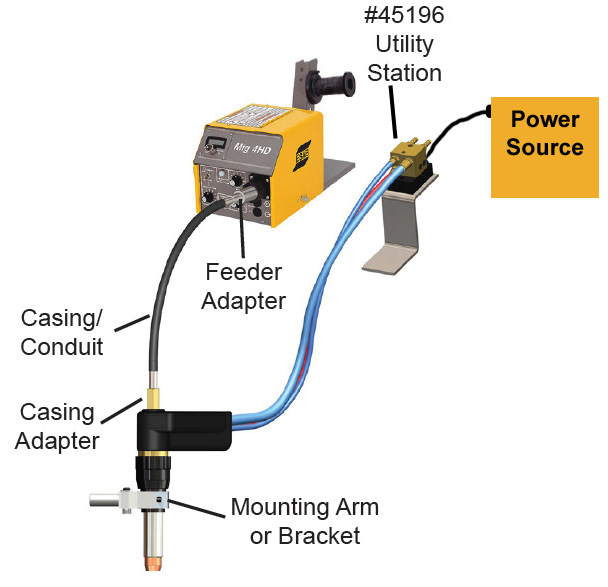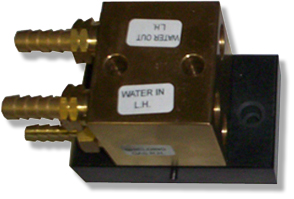
D/F Utility Station #45196
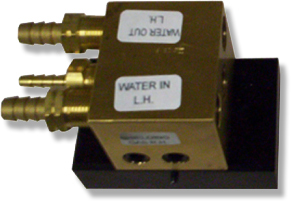
D/F Utility Station #45188
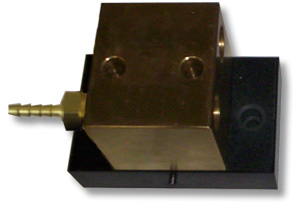
D/F Utility Station #45184
Drawings More Info
Overview
D/F MIG (GMAW) and TIG (GTAW) barrels can hook up to any of the different Miller, Lincoln, Esab, Welding Alloys, Fronius, Tweco, etc., power sources and wire feeders. Every wire feeder manufacturer has different sized holes where the torch's conduit or casing plugs into the wire feeder. They call these pins 'power pins'. Typical modern torch setups utilize a unitized cable assembly with a power pin. The gas, water, power and conduit are combined into a single replaceable unit. When one cable goes bad, the whole unit is replaced. This can be expensive. Also, this approach does not allow for a large enough inner power cable needed for necessary high amperages, and it is restricted in size by small passages for water, gas and wire. Water-cooling and gas coverage are both limited by the size restrictions.
D/F torches take an alternative approach to the setup. The torches use a separate gas hose, water-in hose, Water Out & Power Cable, and casing/conduit. When one cable goes bad it is simply replaced instead of attaching an entire new unitized cable assembly; a huge cost saver! This is also where the D/F Utility Station comes into play. The gas hose, water-in hose, and Water Out & Power Cable are interfaced with the customer's existing lines via the Utility Station. The D/F torch leads plug into the front of the Utility Station. Into the back of the Utility Station go the customer's utilities. The back includes industry standard 3/8" shanks to allow the customer to connect the water in and water out lines, and a 3/16" shank to connect the gas line. Along with these hoses, the customer must plug the a 4/0 power cable directly from the power source to the back of the Utility Station. This is how the D/F torches are powered, NOT with a power cable to the wire feeder; there can be no jumper cable from the drive roll to the Utility Station. The power must travel through the Utility Station and down to the torch via the Water Out & Power Cable, hence the name. It is most important to remove the 4/0 power cable from the lug of the wire feeder drive roll stand, strip the cable back roughly 2", and insert the 4/0 power cable into the back of the D/F Utility Station. Finally, a short gas hose jumper is needed for control of the gas. Remove the small black 3/16" hose that connects from the solenoid to the feeder input inside the wire feeder. The jumper can be attached by removing the 3/16" hose from the solenoid, and attaching the 3/16" gas jumper hose to the solenoid and to the back of the D/F Utility Station's 3/16" shank.
The Utility Station 45196 is the D/F Standard Utility Station for connecting one 4/0 power cable. The front of the Utility Station where the torch is connected accepts a D/F gas hose, a D/F water-in hose, and one D/F Water Out & Power Cable. The back of the Utility Station accepts a single water in hose with a 3/16" shank, a single water out hose with a 3/16" shank, a single gas hose with a 3/16" shank, and a single 4/0 power cable that is held in by socket set screws.
The Utility Station 45188 is the D/F Dual Power Utility Station for connecting two 4/0 power cables. On the front it accepts a D/F gas hose, a D/F water-in hose, and two (2) D/F Water In/Out & Power Cables. On the back it accepts a single water in hose, a single water out hose, a single gas hose and two 4/0 power cables that are held in by socket set screws.
The Utility Station 45184 is the D/F Utility Station for air-cooled torches for connecting one 1/0 power cable. On the front it accepts a D/F gas hose and a D/F 1/0 power cable that is held in by socket set screws. On the back it accepts a single gas hose and a single 1/0 power cable that is held in by socket set screws. Each Utility Station is also fitted with a voltage sensing lead.
Due to the fact that every welding application is different because of size restrictions, access restrictions, positioning restrictions, etc., we have a solution for your unique application. By using separate utilities and a Utility Station, the D/F torches can carry more power, run cooler, provide more gas coverage, withstand extreme conditions (1000 degree pre-heat), increase weld quality (X-ray quality welds), and run the full range of wire through 1/8".
For more information on proper use of the D/F Utility Station, and to see the various torch connection options, please download the Torch Connection Options one-sheet.
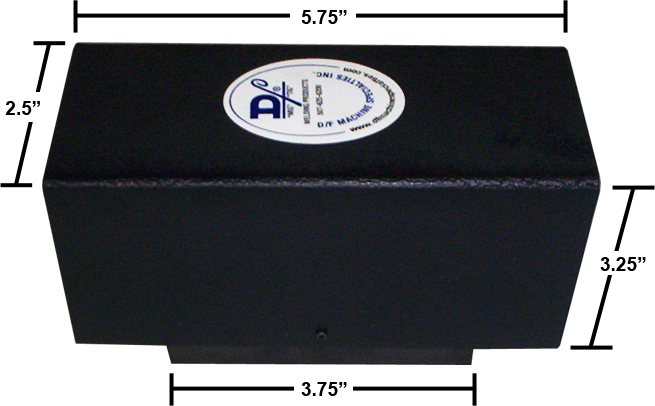
D/F Utility Station Model 45196
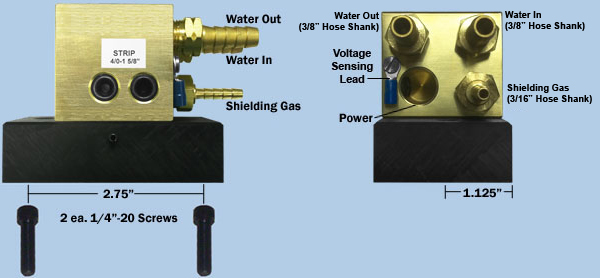
D/F Utility Station Model 45188 (Dual Power)
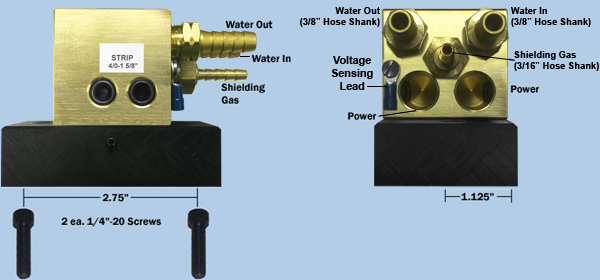
D/F Utility Station Model 45184 (Air-Cooled Barrels)
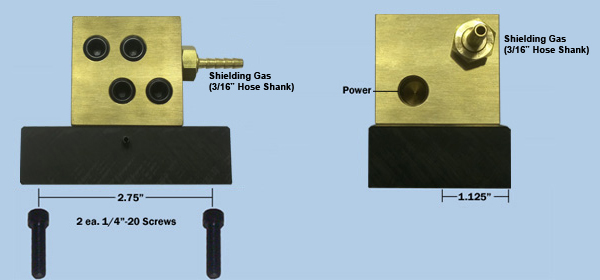
Ordering Information
| DESCRIPTION | CODE NO. |
|---|---|
| Utility Station (Air-Cooled Barrels) | 45184 |
| Utility Station (Dual 4/0 Power Cables w/ Voltage Sensing Lead) | 45188 |
| Utility Station Standard (Single 4/0 Power Cable w/ Voltage Sensing Lead) | 45196 |
Manuals & Downloads
Other Documents
| DESCRIPTION | DOWNLOAD |
|---|---|
| Torch Connection Options | |
| Utility Stations One-Sheet |
Directly and Remotely Mounting D/F Torches
Not only are D/F torches water-cooled on the inside of the body, the nozzle is also water-cooled. The water cooled nozzle (the front of the D/F torch) is insulated from the body that is carrying the current. If a torch is properly mounted on the insulated body and not touching metal, you can actually grab the front of the torch because it is not hot. Since the water-cooled nozzle is insulated from the hot body, and because of the superior water cooling, the front nozzle will also be cool to the touch after welding at high amperage and preheat. This installation allows everything to run cooler and last longer.
Using the D/F #45196 utility station allows the torches to be connected in two completely different ways--directly or remotely. To directly connect a D/F torch to the wire feeder, simply thread the correct feeder adapter for the power source into the top of the D/F torch and plug the torch into the wire feeder. The utilities leave the torch at a 90 degree angle and can be connected to the utility station.
Remote connection of a D/F torch requires a mounting bracket or robotic mounting arm to grab the torch. This arm or bracket is then mounted on a robot, fixture, gantry, x- y- z axis, or above a positioner or manipulator. The wire is brought into the torch through a conduit/casing (usually from 4ft-15ft). Remote mounting enables customers to get the wire feeder away from the pre-heat, torch heat, and the work. It also allows the end user to access hard to reach areas. Furthermore, it allows for all of the utilities to be protected together inside a fire resistant sheath.
A third mounting variation exists that somewhat combines direct and remote mounting and includes the utility station. A direct mount torch can be remotely mounted. We make this possible by putting an adapter on the top of the direct mount torch. This adapter will allow you to now attach a casing/conduit on the top of the torch and get the torch anywhere from 1-15 feet away from the heat. This method of remotely mounting a direct mount torch is preferred in installations where there is limited room for mounting and running the lines. This allows for easy access to the casing/conduit to be changed out, and for ease in changing liners. This method is used in hard banding applications by mounting a “dog bone” on the front of the water-cooled nozzle of the torch, and off of that mount will come the cold wire feed or sub arc attachments.
Examples of the two main mounting methods, direct and remote, and the third optional method are listed below:
Direct Mount Torches
The torch is directly connected to (plugged into) the wire feeder.
Direct Mount Water-Cooled-to-the-Tip Torches
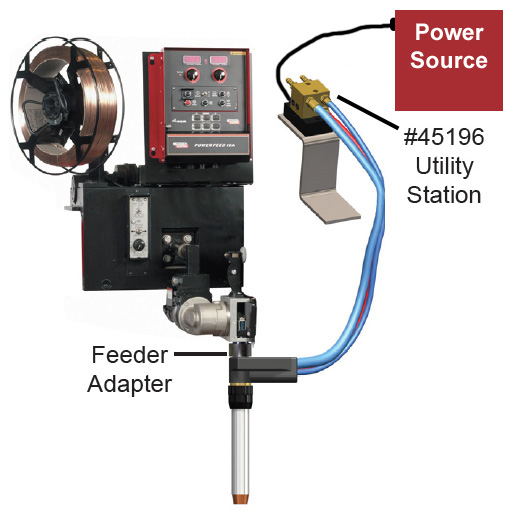
Remote Mount Torches
The torch is mounted away from the wire feeder and requires a casing or conduit to run wire to the torch.
Remote Mount Water-Cooled-to-the-Tip Torches
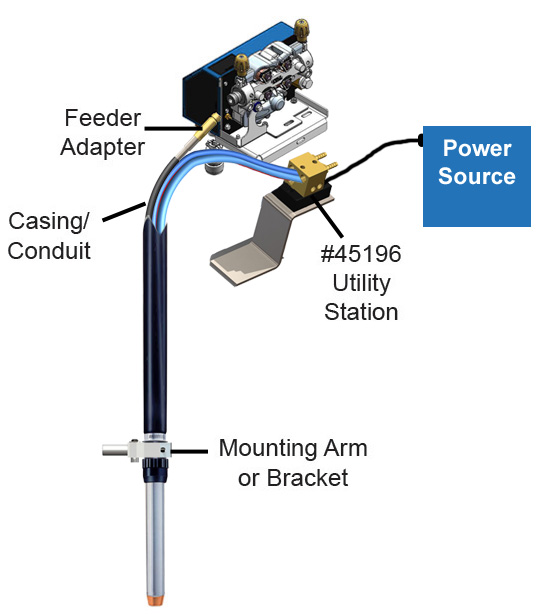
Remotely Mounted Direct Mount Torches
Remotely mount a direct mount torch.
